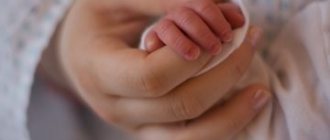Redness of the navel in a 5 year old child
The occurrence of an inflammatory process of the skin in the navel area can occur not only in newborns, but also in older children.
- One of the reasons why a child may have omphalitis is the congenital anatomical features of the navel structure.
- The umbilical canal may be narrow or retracted, which increases the risk of a buildup of dead skin cells and sebaceous glands.
- Damage to the navel in a child can also lead to the development of omphalitis. When injured, infection may occur and an inflammatory process may begin.
- If the wound that occurs in the umbilical canal is not properly cared for, omphalitis occurs.
- The development of the disease is especially likely in children with reduced immunity. With a reduced efficiency of the immune system, the body cannot cope with the development of infection. In such children, the likelihood of complications increases significantly.
It is easy to determine the inflammatory process in a child’s skin in the navel area. Signs of omphalitis vary depending on the form of the disease.
- With purulent omphalitis, purulent masses form in the umbilical canal, and swelling and redness of the skin around the navel appears.
- There is an expansion of the veins on the anterior abdominal wall, which is clearly visible.
- The child may be capricious, feel restless, sleep poorly, and have a decreased appetite.
- With the rapid development of purulent omphalitis, the navel begins to protrude above the surface of the skin.
- If a baby has a weeping form of omphalitis, instead of pus, fluid appears in the umbilical canal.
- If the liquid dries out, crusts form on the navel.
- With weeping omphalitis, the child may feel well, but this form of the disease provokes the spread of the inflammatory process to neighboring areas of the skin.
Diagnosis of omphalitis in a child
- A doctor can diagnose an inflammatory process in the umbilical canal during an initial examination. The child must be shown to a pediatrician and surgeon.
- To determine the causative agent of an infectious disease, it is necessary to submit a sample of discharge for bacteriological culture.
- Tank culture helps determine the sensitivity of the pathogen to antibacterial drugs.
- The child may be prescribed an ultrasound examination to prevent complications in the form of abscesses or phlegmon of the abdominal cavity.
- An abdominal x-ray can also be performed to identify complications of omphalitis in a child.
- To determine the general condition of the body, the child is prescribed a general blood and urine test.
The occurrence of complications of the disease in children is rare.
With timely diagnosis and correctly prescribed treatment, consequences and complications after omphalitis do not arise. But how dangerous is the disease if complications arise? There is a possibility of developing pathologies of various organs and systems.
- An inflammatory process of the lymph nodes called lymphangitis may develop.
- The occurrence of a purulent process in soft and bone tissues, as well as in the bone marrow.
- The development of phlebitis - inflammation of the veins.
- The onset of an inflammatory process in the intestinal mucosa or enterocolitis.
- Development of sepsis. Sepsis is a blood infection that can be fatal.
- The onset of inflammation in the arteries called arthritis.
- Inflammatory process in the abdominal wall.
Therefore, the child may be hospitalized to prevent the development of complications.
You can prevent the development of an inflammatory process in a child in the navel area by following simple rules.
- If the anatomical structure of the umbilical canal predisposes to the development of omphalitis, it is necessary to monitor the skin in this area.
- If the navel is damaged, the resulting wound should be promptly disinfected. For this, water or alcohol antiseptics, as well as hydrogen peroxide, are used.
- If necessary, you need to use dressings or a plaster, which must be changed frequently.
- Increase the efficiency of the immune system with the help of fresh vegetables and fruits, as well as vitamin and mineral complexes. But taking vitamins should occur after consulting a doctor. To increase immunity, the child must be in the fresh air every day, follow a daily routine and eat well.
Arm yourself with knowledge and read a useful informative article about omphalitis in children. After all, being parents means studying everything that will help maintain a degree of health in the family on the island.
Find out what can cause the disease and how to recognize it in a timely manner. Find information about the signs that can help you identify illness. And what tests will help identify the disease and make a correct diagnosis.
In the article you will read everything about methods of treating a disease such as omphalitis in children. Find out what effective first aid should be. How to treat: choose medications or traditional methods?
You will also learn how untimely treatment of omphalitis in children can be dangerous, and why it is so important to avoid the consequences. All about how to prevent omphalitis in children and prevent complications.
And caring parents will find on the service pages complete information about the symptoms of omphalitis in children. How do the signs of the disease in children aged 1, 2 and 3 differ from the manifestations of the disease in children aged 4, 5, 6 and 7? What is the best way to treat omphalitis in children?
Take care of the health of your loved ones and stay in good shape!
detstrana.ru
The reason for the redness of the navel in a child
With the birth of a baby, parents may encounter all sorts of difficulties and childhood diseases that adults had never even thought about before. Such troubles include a red belly button in a baby.
Causes of navel redness
The reason for the redness of a child's navel can lie in completely different situations.
Firstly, the most common cause of a red belly button is an unhealed wound on the navel. No matter how hard parents try to maintain sterility and follow all hygiene standards, it is quite difficult to protect their child from germs.
After all, they can be everywhere: in the air, on mother’s clothes, toys and all other surrounding objects. When the umbilical wound of a newborn is still open, microbes can easily get into it, causing inflammation.
Doctors call such an inflammatory process that develops inside the umbilical wound, affecting the umbilical ring and the skin around it, as omphalitis.
The danger of this inflammation lies not so much in the fact that the child becomes capricious, eats and sleeps poorly, and loses weight, but in the fact that microbes can begin to move inside the body, entering the blood and with it to any other organs.
If a child’s navel turns red, parents should carefully monitor the accompanying symptoms. This is done in order to exclude the development of omphalitis, or if it is confirmed, to begin immediate treatment.
Symptoms of inflammation of the umbilical wound:
- Swelling of the area around the navel, and when you touch it, you feel hot.
- There is a palpable pulsation of blood in the navel.
- The red navel is a bright shade that is difficult to confuse with anything else.
- Purulent or watery discharge may appear.
- Increased temperature of the whole body.
If these symptoms are detected, you should contact your pediatrician for help as soon as possible. If there is delay, complications and long-term treatment are possible, up to several months. As a rule, the doctor prescribes 2-3 single treatments of the navel with antiseptics and disinfectants.
In rare cases, an antibiotic may be needed. Hydrogen peroxide helps a lot; it dries the skin well without staining it. If a child’s condition noticeably worsens or improves, the doctor will notice it immediately.
They try not to use brilliant green, as after it there is a risk of souring the navel.
Secondly, after the umbilical cord dries out, the skin may also have a reddish tint, but this is not considered a pathology and is the norm. The red belly button will go away in a few days if the mother follows all the hygiene standards for the newborn.
Thirdly, the reason for the redness of a child’s navel may lie in the incorrect wearing of a disposable diaper. For the first days of a baby's life, special low-waist diapers have been developed that do not touch the navel.
If parents, for whatever reason, cannot buy such a product, then doctors advise bending the edge of regular diapers down a few centimeters so that the delicate skin of the navel does not come into contact with the surface of the diaper.
Fourthly, in the 7-10 month period, a red navel is often observed in babies due to their curiosity. Children at this age actively learn about the world around them and their body. Many babies enjoy playing with their belly button. As a result, redness appears in the navel area.
Fifthly, a child’s navel may turn red due to an allergic reaction. Allergies can occur to cosmetics, complementary foods, or for a number of other reasons.
Omphalitis of the umbilicus in newborns
Mom's actions that will help avoid infection in the open umbilical wound, thereby preventing the appearance of a red navel with omphalitis:
- The umbilical remnant should fall off on its own; no effort is needed for this.
- Bathe your baby only in boiled water.
- Do not allow moisture to accumulate in the navel. After water procedures or if moisture gets on the umbilical wound, you must carefully blot the umbilical area with a cotton diaper or a soft absorbent towel. There is no need to rub or press hard on the navel.
- An unhealed umbilical wound must be treated daily with brilliant green or other drugs with a similar effect.
- You should perform air baths several times a day, bringing each procedure to 15 minutes.
- During the first days, you can add several crystals of potassium permanganate to the bathing water. To avoid burns, the water must be uniform and free of undissolved crystals.
- Treat the navel every day and monitor its condition.
- Keep an eye on growing children's nails and trim them as needed.
- Children's clothing and bedding should be made only from natural fabrics.
- Wash clothes only with special baby powders.
- If you suspect that your navel is souring, you should immediately treat this area with peroxide.
A child’s navel may turn red not only during the newborn period, but also at an older age. For example, a red navel can be observed in both one-year-old babies and 2-3 year olds.
This is due to the fact that even after the umbilical wound has healed in the first weeks of life, the navel is a very vulnerable place for germs and bacteria.
Some mothers forget to pay attention to the baby's navel and do not clean its cavity, thereby creating favorable conditions for the development of microorganisms.
Red navel in a child: causes, diagnosis, treatment and prevention
The umbilical wound is one of the most vulnerable places on the body of a newborn baby. It creates a favorable environment for the proliferation of harmful microorganisms, and therefore the baby’s navel should be constantly cared for and monitored.
Even after complete healing of the postpartum wound, the risk of infection through the umbilical fundus remains increased: here, in the recess, microorganisms can live, which, under certain conditions, are activated and provoke inflammation.
Therefore, a child’s red belly button can be observed even at an older age: closer to a year, and even at 2-3 years.
The reasons for the redness of the navel are completely different, but this phenomenon should never go unnoticed by parents.
Red navel in a child: causes
The most serious and dangerous cause of redness of the navel in a child is omphalitis . This is a bacterial inflammation of the bottom of the umbilical wound, the umbilical ring and surrounding tissues.
Omphalitis is characterized by severe redness of the skin in the umbilical area (it becomes bright red), swelling and swelling, hyperthermia (increased skin and body temperature), and a few days after the appearance of these signs, purulent discharge may be observed.
Omphalitis causes discomfort to the baby and to a certain extent affects his well-being and health. The child may be weakened, capricious, restless, sleep poorly, eat poorly, and even lose weight. But the main danger lies in the fact that bacteria penetrate deep into the umbilical fundus, enter the blood and can thus spread the infection throughout the body.
Omphalitis usually occurs in newborns in the first days and weeks of life. But a child’s red belly button can also be observed in later periods of his development.
Around the end of the third month of its development, the newborn begins to explore its hands and find all sorts of activities for them. Later, he enthusiastically studies the body and its individual parts.
In this process, babies often find a belly button on their tummy and play enthusiastically, picking at it with their fingers.
Such manipulations often cause redness in children 7, 8, 10 months old and even older!
Another likely cause of a red belly button is allergic reactions.
This may be a reaction of the child’s body to a new product introduced into his or the mother’s diet (if the baby is breastfed), to washing powder or baby cosmetics, to new diapers and even clothes! Any rubbing, irritation, diaper rash, contact with chemical or synthetic substances can cause redness and swelling on the skin of children, including in the navel area. And in babies, the skin in this place may turn red even after strong straining or hysterical crying.
Catarrhal omphalitis
This is a simple type of disease. People call it “wet navel.”
The pathology is characterized by the following symptoms:
- Minor discharge from the wound. As a rule, this is how the development of the disease begins. The discharge may be serous. Sometimes the bleeding navel in newborns even contains purulent fragments. Discharge may appear and disappear.
- Swelling of the umbilical ring. This symptom is very often observed during the development of pathology, but it is not obligatory. The umbilical ring turns red and swells. The skin becomes shiny and stretched.
- Fungus may occur (it resembles a mushroom-shaped growth). This is a pale pink dense formation. In most cases, it does not cause discomfort to the baby, but it can easily fester if infected. Infection often occurs when the fungus is damaged during swaddling or changing clothes of the baby.
With the development of the catarrhal variety of the disease, the baby feels great. He sleeps well, eats with appetite, and is gaining weight well.
But treatment of the disease must begin immediately. If you do not fight the disease at this stage, the pathology will begin to progress.
Red belly button in a child: what to do?
Omphalitis certainly requires treatment, which should be prescribed by a specialist.
In complex advanced cases, the child may even need to be shown to a dermatologist or surgeon, but the pediatrician will judge this need after an in-person examination. Quite often it is possible to eliminate the problem on your own, simply by adhering to the rules of caring for the navel and paying increased attention to the hygiene of this area:
- Always dry the navel thoroughly after water procedures, avoiding the accumulation of liquid in it.
- In the first days and weeks of the baby’s life, do not cover the umbilical wound with a diaper - it must “breathe” until it heals.
- Give your child air baths more often, allowing the navel to dry naturally.
- Trim growing children's nails in a timely manner.
- Buy your child underwear only from natural fabrics.
- Do not use synthetic laundry detergents on children's clothing.
- If the slightest souring occurs in the umbilical wound, treat this area with peroxide or a solution of potassium permanganate. After this, blot the moisture dry with sterile cotton wool.
- Try to avoid eating highly allergenic foods if you are breastfeeding and introducing them into your baby's complementary foods.
However, the situation often requires qualified help and medication. It is necessary to take your child to the doctor if you observe the following symptoms - just one of them or several at once:
- increased skin temperature around the navel;
- increased body temperature;
- visible swelling and “bloating” of the skin around the umbilical wound;
- discharge of fluid or pus;
- pulsation in the area around the navel.
Based on the condition and type of umbilical inflammation, the pediatrician will determine treatment tactics and advise what to do next.
Usually, for omphalitis, antibacterial and disinfectants are prescribed; in some cases, the antibiotic will need to be taken orally or administered intramuscularly (but only after culturing the flora for sensitivity to antibiotics). It is necessary to treat the area of inflammation several times a day for 2-3 weeks.
A variety of means can be used for disinfection and drying.
Most of all, doctors like to advise 3% hydrogen peroxide in such situations - it dries well and does not stain the skin, and this is important when it is necessary to assess the condition of the navel and the tendency for improvement/deterioration.
In addition, brilliant green has recently not been prescribed at all for treating the umbilical wound, since after it the wound often begins to get wet and sour.
Prevention
You can prevent the development of an inflammatory process in a child in the navel area by following simple rules.
- If the anatomical structure of the umbilical canal predisposes to the development of omphalitis, it is necessary to monitor the skin in this area.
- If the navel is damaged, the resulting wound should be promptly disinfected. For this, water or alcohol antiseptics, as well as hydrogen peroxide, are used.
- If necessary, you need to use dressings or a plaster, which must be changed frequently.
- Increase the efficiency of the immune system with the help of fresh vegetables and fruits, as well as vitamin and mineral complexes. But taking vitamins should occur after consulting a doctor. To increase immunity, the child must be in the fresh air every day, follow a daily routine and eat well.
You will also learn how untimely treatment of omphalitis in children can be dangerous, and why it is so important to avoid the consequences. All about how to prevent omphalitis in children and prevent complications.
And caring parents will find on the service pages complete information about the symptoms of omphalitis in children. How do the signs of the disease in children aged 1, 2 and 3 differ from the manifestations of the disease in children aged 4, 5, 6 and 7? What is the best way to treat omphalitis in children?
Take care of the health of your loved ones and stay in good shape!
Medicines, equipment and methods are improved every year. Only the parents' worries about their children remain unchanged. The most troublesome is the first year after birth.
First…
A woman who has become a mother for the first time pronounces the epithet “first”, regarding a newborn, very often. The first cry, the first feeding, the first smile, the first wound or injury. The latter seem inevitable for such a baby: everything about her is so small, tender, and looks vulnerable.
The greatest worries in this regard are caused by the anterior fontanel and the navel: what if the first one does not close or the second one comes undone? And for the newborn itself, during the mother’s experiences for several months (up to a year) after birth, it is more important that they are properly cared for and protected.
And if there are no special rules for the fontanel (the main thing is not to rub it with a towel after bathing, but to get it wet), then for the umbilical wound the following are mandatory:
- timely change of the absorber (absorbent pad, diaper, diaper);
- treating the navel and the skin around it with a cotton swab previously moistened with a disinfectant liquid (for example, hydrogen peroxide) when changing the absorber;
- Make sure that the edge of the absorber does not touch or cover the wound.
You cannot bathe your child until the umbilical cord falls off on its own. Air baths, which help the umbilical wound dry out, are the best prevention of possible complications.
Causes
Of course, there is no need to faint. Not every redness causes serious illness. And even blood poisoning is not the cause of redness, but a consequence. Occurs infrequently if everything is done correctly.
But first you need to understand what caused the redness.
- Frequent rubbing of clothing or diaper on the umbilical wound. Whatever one may say, this is irritating.
- Omphalitis. It is not dangerous in itself, but if neglected it will become a cause for serious concern.
- Falling off umbilical remnant. Yes, this could also be the root cause. But only very different from others. Firstly, the color is not so pronounced, but pale. Secondly, it goes away in a couple of days. Doesn't cause any concern.
So, the most serious cause is omphalitis. This is an inflammatory formation that can be accompanied by unpleasant symptoms.
Signs of illness
Omphalitis itself is a red blister inside the navel. Sometimes not one, but several. If this problem does not develop, then it does not pose a danger. Another point is that this is an open path for infection. And here a bad scenario is already developing. Here are the threats the baby faces:
- Sepsis. Even completely cured will further weaken the body. After all, you can’t cope with it without antibiotics! It takes a child at least a year to recover from such therapy.
- Fungal growth. No, this is not terrible sepsis, but it still slows down healing. The wound is constantly getting wet and inflamed. And this is a risk of catching something else. After all, a non-healing wound is an excellent environment for pathogenic microbes.
- Hepatitis. Unfortunately, the process involves blood vessels communicating with the liver. And this can easily lead to hepatitis and even cirrhosis.
- Phlegmon. A disease requiring surgical intervention.
These diseases are caused by severe inflammation. To avoid this, pay attention to these warning signs:
- Redness of the navel and peri-umbilical area.
- There is intense heat coming from the navel.
- Pulsation of the reddened area.
- Often the umbilical ring begins to get wet and pus is released.
These are the signs at which you need to sound the alarm and seek medical help. Even the initial stage of omphalitis needs attention from medical staff. Simple treatments will no longer help here. Proper treatment is needed.
Treatment
It goes without saying that only a doctor prescribes treatment. You cannot do this on your own using online resources. It’s one thing if the baby’s omphalitis has just begun. An ordinary lapis pencil can help here. And it’s another matter when an infection enters the baby’s body. Methods can be very different. Then I summarized what medications are generally possible in this situation:
- Drying agents. For this, regular peroxide is often recommended. By the way, there is an opinion that peroxide does not dry out the wound, but wets it! Is it so? So, if handled incorrectly. There is one secret: after treating with peroxide, you need to blot the umbilical ring well. Apply the antiseptic to a dry surface. And then everything will be OK!
- Antiseptics. In mild stages, sometimes they get by with simple green paint. The number of treatments simply increases depending on the situation.
- Antibiotic therapy. This is in more advanced cases when an infection has started. Just know that first the doctor must test the baby for sensitivity to these antibiotics. For what? Yes, so that the correct drug is prescribed.
Well, these are medications prescribed by a doctor. What can parents do at home to prevent sad consequences?
Source: https://gippokrat-miass.ru/zabolevaniya/pochemu-pupok-krasnyj.html
The navel turned red in a 6 month old baby
Omphalitis most often occurs in babies in the first weeks of life. The disease is caused by an infection of the umbilical wound. This is manifested by redness of the skin in the circumference, swelling, purulent discharge, fever and abdominal pain.
The immediate cause of hyperemia of the skin around and inside the umbilical fossa is infection. These can be bacteria (usually staphylococcus, streptococcus, Pseudomonas aeruginosa/Escherichia coli) or fungi.
But for its penetration into tissues, certain conditions are required:
- Fistula. As a rule, this is a congenital pathology that occurs against the background of an open urinary/intestinal duct. In this case, intestinal contents or urine are released through the canal;
- Acquired fistula. This is formed due to inflammation of the anterior abdominal wall, which provokes the opening of a purulent abscess;
- Anatomical features. If the skin umbilical canal is deeply retracted/excessively narrow, keratinized cells and sebum accumulate in it. If you do not follow the rules of personal hygiene, there is a high probability of infection and further inflammation;
- Wound. Improper wound care also increases the risk of infection. Any damage to the skin is an open gate for infections. For example, people who have had a navel piercing but do not properly care for the piercing site often suffer.
Redness of the navel in adults and other symptoms of omphalitis
Main signs: redness, swelling and serous discharge inside the fossa. When the inflammatory process is complicated, the latter include impurities of pus/blood.
The general condition of a person also worsens due to intoxication. The temperature stays between 38-39°C. Inflamed skin becomes more protruding and hot to the touch, especially at the site of inflammation.
The wound itself becomes covered with a crust, under which purulent masses accumulate.
The infection can spread to surrounding, still healthy tissues, as well as blood vessels. Against this background, phlebitis or arteritis develops - the most dangerous variant of the disease.
Forms of the disease
There are three forms of the disease, each of which is a consequence of the previous one:
- Simple (wet). The patient's general condition remains satisfactory. Of the external symptoms, only weeping with purulent/serous discharge is observed. The latter dry out, forming a thin crust. If you do not intervene, multiple pink granulations and mushroom-shaped tumors form;
- Phlegmonous. This form is characterized by the involvement of healthy tissues in the pathological process. The patient's general condition is gradually deteriorating. With the development of phlegmon, the temperature can jump to 40°C. The navel becomes like an ulcer, surrounded by a dense skin ridge. When pressed, pus may appear. The skin around the navel becomes very inflamed, swollen, and painful on palpation;
- Necrotic (gangrenous). This form develops very rarely and mainly in people with very weak immune systems. It is characterized by the spread of the pathological process to nearby internal organs. When all layers of the peritoneal wall are affected, peritonitis develops. The necrotic form is accompanied by necrosis (death) of the skin and subcutaneous tissue in the navel area. Subsequently, the underlying tissues also peel off. The affected skin becomes dark (looks like a bruise). Against the background of the disease, ulcers may form. The infection can reach the blood vessels, causing sepsis.
Redness of the navel in newborns
What other problems may arise with the navel in babies in the first weeks of life:
- The wound is bleeding, the skin is red or blue - symptoms of injury. This can happen due to careless hygienic manipulations or when putting on clothes/diapers, turning the baby over, etc. It is necessary to treat the stomach with peroxide and lubricate it with an antiseptic solution. If symptoms persist, consult a doctor;
- Redness and weeping - the presence of a foreign body in the navel. It is necessary to visit a surgeon to carry out the appropriate manipulations;
- Redness without inflammation is a skin injury. This is often observed in babies 6-10 months old - they are actively exploring their body. Another reason is allergies, food or contact. But in this case, rashes will also be observed on other parts of the body.
What to do?
Regardless of the indirect cause of inflammation, immediate action must be taken. Otherwise, the infection will spread. It is necessary to visit a surgeon and, if necessary, submit the discharge for bacteriological analysis.
Usually the disease is treated with conservative methods. Radical (surgical) treatment is used only in the presence of a fistula. Timely initiation of therapy guarantees quick relief from the disease and the elimination of complications.
Treatment of a simple form
Every day you need to wash your navel with antiseptic agents: hydrogen peroxide or furatsilin solution. It also needs to be lubricated with 70% alcohol, 1% brilliant green or 5% potassium permanganate. Supplement local treatment with ointments: tetracycline or syntomycin 1%.
If granulations appear, the wound is washed with 3% hydrogen peroxide, and they are cauterized with lapis (10% silver nitrate solution). If necessary, the doctor will prescribe ultraviolet irradiation.
Basal temperature from A to Z
BeTeshka is your assistant in pregnancy planning
* Dear friends! Yes, this is an advertisement, you have to spin like that!
The child's belly button is red
The child is 7 months old. About 10 days ago my belly button turned red. I smeared it with brilliant green, then washed it every day with peroxide. And now the green stuff has washed off and the belly button is still red. There is no unpleasant smell and it doesn’t seem to bother the child, but I don’t understand why. Give me some advice!
Red navel in a 7 month old baby
Hi all! After the birth of a baby, one of the problems may be a red navel in a newborn. Is this a pathology or the norm? It depends in what case. Sometimes this leads to irreversible consequences, such as blood poisoning. Let's figure it out together.
Of course, there is no need to faint. Not every redness causes serious illness. And even blood poisoning is not the cause of redness, but a consequence. Occurs infrequently if everything is done correctly.
But first you need to understand what caused the redness.
- Frequent rubbing of clothing or diaper on the umbilical wound. Whatever one may say, this is irritating.
- Omphalitis. It is not dangerous in itself, but if neglected it will become a cause for serious concern.
- Falling off umbilical remnant. Yes, this could also be the root cause. But only very different from others. Firstly, the color is not so pronounced, but pale. Secondly, it goes away in a couple of days. Doesn't cause any concern.
So, the most serious cause is omphalitis. This is an inflammatory formation that can be accompanied by unpleasant symptoms.
Red navel in a newborn
You probably know that an important part of childbirth is the cutting and ligation of the newborn baby's navel. Thus, the child loses physical connection with the mother, becoming an independent organism.
But along this path, the mother must provide every possible care for the newborn. Treating the umbilical wound should be an important step in your baby’s daily toilet routine.
And if you notice that your newborn baby has a red navel, signs of suppuration, and your baby is restless, you need to consult a doctor about the treatment of omphalitis (inflammation of the navel and nearby tissue). The danger for a newborn is that his body is deprived of strong protection, and the slightest infection can lead to dire consequences.
Causes
The occurrence of an inflammatory process of the skin in the navel area can occur not only in newborns, but also in older children.
- One of the reasons why a child may have omphalitis is the congenital anatomical features of the navel structure.
- The umbilical canal may be narrow or retracted, which increases the risk of a buildup of dead skin cells and sebaceous glands.
- Damage to the navel in a child can also lead to the development of omphalitis. When injured, infection may occur and an inflammatory process may begin.
- If the wound that occurs in the umbilical canal is not properly cared for, omphalitis occurs.
- The development of the disease is especially likely in children with reduced immunity. With a reduced efficiency of the immune system, the body cannot cope with the development of infection. In such children, the likelihood of complications increases significantly.
Symptoms
It is easy to determine the inflammatory process in a child’s skin in the navel area. Signs of omphalitis vary depending on the form of the disease.
- With purulent omphalitis, purulent masses form in the umbilical canal, and swelling and redness of the skin around the navel appears.
- There is an expansion of the veins on the anterior abdominal wall, which is clearly visible.
- The child may be capricious, feel restless, sleep poorly, and have a decreased appetite.
- With the rapid development of purulent omphalitis, the navel begins to protrude above the surface of the skin.
- If a baby has a weeping form of omphalitis, instead of pus, fluid appears in the umbilical canal.
- If the liquid dries out, crusts form on the navel.
- With weeping omphalitis, the child may feel well, but this form of the disease provokes the spread of the inflammatory process to neighboring areas of the skin.
Complications
The occurrence of complications of the disease in children is rare. With timely diagnosis and correctly prescribed treatment, consequences and complications after omphalitis do not arise. But how dangerous is the disease if complications arise? There is a possibility of developing pathologies of various organs and systems.
- An inflammatory process of the lymph nodes called lymphangitis may develop.
- The occurrence of a purulent process in soft and bone tissues, as well as in the bone marrow.
- The development of phlebitis - inflammation of the veins.
- The onset of an inflammatory process in the intestinal mucosa or enterocolitis.
- Development of sepsis. Sepsis is a blood infection that can be fatal.
- The onset of inflammation in the arteries called arthritis.
- Inflammatory process in the abdominal wall.
Baby's red belly button
The umbilical wound is one of the most vulnerable places on the body of a newborn baby. It creates a favorable environment for the proliferation of harmful microorganisms, and therefore the baby’s navel should be constantly cared for and monitored.
Even after complete healing of the postpartum wound, the risk of infection through the umbilical fundus remains increased: here, in the recess, microorganisms can live, which, under certain conditions, are activated and provoke inflammation.
Therefore, a child’s red belly button can be observed even at an older age: closer to a year, and even at 2-3 years.
The reasons for the redness of the navel are completely different, but this phenomenon should never go unnoticed by parents.
Red navel in a child: causes
The most serious and dangerous cause of redness of the navel in a child is omphalitis . This is a bacterial inflammation of the bottom of the umbilical wound, the umbilical ring and surrounding tissues.
Omphalitis is characterized by severe redness of the skin in the umbilical area (it becomes bright red), swelling and swelling, hyperthermia (increased skin and body temperature), and a few days after the appearance of these signs, purulent discharge may be observed.
Omphalitis causes discomfort to the baby and to a certain extent affects his well-being and health. The child may be weakened, capricious, restless, sleep poorly, eat poorly, and even lose weight. But the main danger lies in the fact that bacteria penetrate deep into the umbilical fundus, enter the blood and can thus spread the infection throughout the body.
Omphalitis usually occurs in newborns in the first days and weeks of life. But a child’s red belly button can also be observed in later periods of his development.
Around the end of the third month of its development, the newborn begins to explore its hands and find all sorts of activities for them. Later, he enthusiastically studies the body and its individual parts.
In this process, babies often find a belly button on their tummy and play enthusiastically, picking at it with their fingers.
Such manipulations often cause redness in children 7, 8, 10 months old and even older!
Another likely cause of a red belly button is allergic reactions.
This may be a reaction of the child’s body to a new product introduced into his or the mother’s diet (if the baby is breastfed), to washing powder or baby cosmetics, to new diapers and even clothes! Any rubbing, irritation, diaper rash, contact with chemical or synthetic substances can cause redness and swelling on the skin of children, including in the navel area. And in babies, the skin in this place may turn red even after strong straining or hysterical crying.
Red belly button in a child: what to do?
Omphalitis certainly requires treatment, which should be prescribed by a specialist.
In complex advanced cases, the child may even need to be shown to a dermatologist or surgeon, but the pediatrician will judge this need after an in-person examination. Quite often it is possible to eliminate the problem on your own, simply by adhering to the rules of caring for the navel and paying increased attention to the hygiene of this area:
- Always dry the navel thoroughly after water procedures, avoiding the accumulation of liquid in it.
- In the first days and weeks of the baby’s life, do not cover the umbilical wound with a diaper - it must “breathe” until it heals.
- Give your child air baths more often, allowing the navel to dry naturally.
- Trim growing children's nails in a timely manner.
- Buy your child underwear only from natural fabrics.
- Do not use synthetic laundry detergents on children's clothing.
- If the slightest souring occurs in the umbilical wound, treat this area with peroxide or a solution of potassium permanganate. After this, blot the moisture dry with sterile cotton wool.
- Try to avoid eating highly allergenic foods if you are breastfeeding and introducing them into your baby's complementary foods.
However, the situation often requires qualified help and medication. It is necessary to take your child to the doctor if you observe the following symptoms - just one of them or several at once:
- increased skin temperature around the navel;
- increased body temperature;
- visible swelling and “bloating” of the skin around the umbilical wound;
- discharge of fluid or pus;
- pulsation in the area around the navel.
Based on the condition and type of umbilical inflammation, the pediatrician will determine treatment tactics and advise what to do next.
Usually, for omphalitis, antibacterial and disinfectants are prescribed; in some cases, the antibiotic will need to be taken orally or administered intramuscularly (but only after culturing the flora for sensitivity to antibiotics). It is necessary to treat the area of inflammation several times a day for 2-3 weeks.
A variety of means can be used for disinfection and drying.
Most of all, doctors like to advise 3% hydrogen peroxide in such situations - it dries well and does not stain the skin, and this is important when it is necessary to assess the condition of the navel and the tendency for improvement/deterioration.
In addition, brilliant green has recently not been prescribed at all for treating the umbilical wound, since after it the wound often begins to get wet and sour.
For drying and disinfection when a child has a red navel, Xeroform, Betadine, chloramphenicol, antibacterial ointments or gels are also prescribed. They should be applied to the wound only after preliminary drying of the umbilical fundus.
The above rules of hygienic care for omphalitis also remain relevant.
No matter how serious the situation may seem to you, you should not worry too much. An inflamed navel can always be cured, the main thing is not to let the situation take its course. Although, if the redness is caused only by temporary mechanical irritation, then it quickly goes away on its own without additional effort on your part.
Especially for nashidetki.net - Larisa Nezabudkina
How to avoid infection?
Dear readers, do you remember that I wrote that primary redness due to omphalitis is not dangerous as such? The danger lies in the fact that the baby's navel in this state becomes vulnerable. And any infection easily penetrates here. To prevent this from happening, follow these simple rules:
- Proper care recommended by a doctor.
- Keep the wound dry. After swimming, be sure to pat dry with a sterile bandage. Only then begin processing. Yes, and apply green paint directly to the wound itself, and not to the skin around it. And until the rest of the umbilical cord falls off, it’s better not to bathe her at all.
- Practice taking air baths.
- Iron the laundry on both sides.
- Add a weak solution of potassium permanganate to the water when bathing.
- Do not wrap your baby in tight clothes and diapers. The wound should be as open as possible. Tuck diapers until the umbilical ring heals. Or use special ones with a cutout for the navel.
By the way, in pediatric departments I often meet mothers with babies who have problems with their belly buttons due to excessive care. Like this? Yes, that's it. After all, doctors first recommend treating the wound once, maximum twice a day. And caring parents can rinse it four times and apply something like that. They think that this speeds up healing.
Everything is good when in moderation. Excessive treatments are detrimental. The umbilical ring becomes wet and may fester. Remember that the number of washes is determined by the doctor. Don't overdo it.
Now tell us what caused the redness in your baby? Is it accompanied by any discharge or odors? What does the doctor recommend? How do you care for a wound at home? Leave comments and become blog subscribers. Until next time. Bye!











